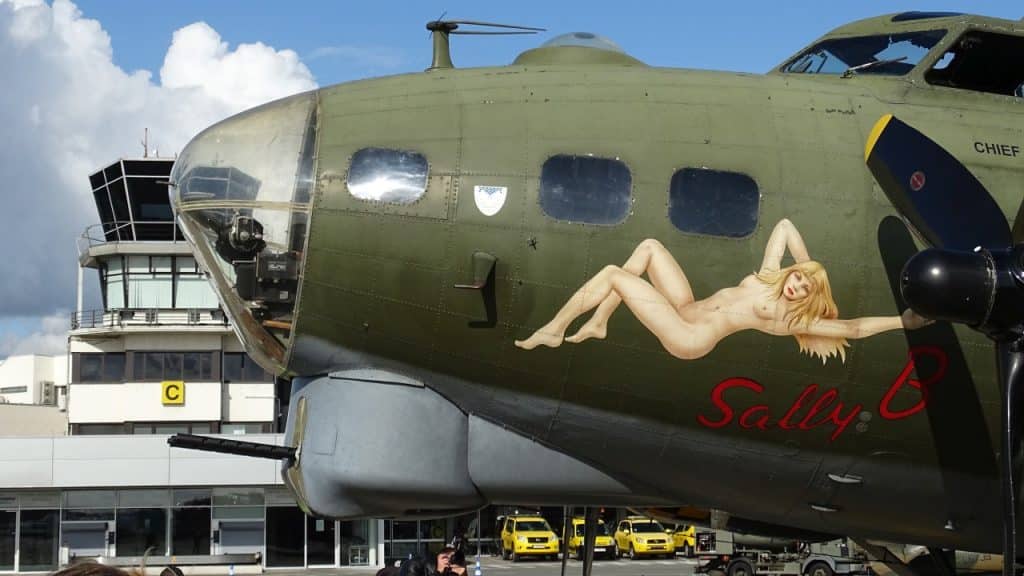After five weeks of forced grounding, Sally B took to the air again. Normally stationed at the Imperial War Museum Duxford (serial number 44-85784, civilian registration G-BEDF), the aircraft has now resumed public appearances and its operator, B-17 Preservation Ltd, is planning an intensive season, including a flight to France.
The Sally B is Europe’s only B-17 Flying Fortress bomber still airworthy. Its permanent grounding would be a great loss to the airshow scene this side of the Atlantic. But of course, relegating Sally B to a stationary museum exhibit is nothing compared to the possibility of losing the plane and its crew in a plane crash. The grounding was intended to prevent this worst-case scenario.
The suspension of Sally B flights resulted from the decision of the US Federal Aviation Administration (FAA), which ordered a structural strength check of the wing spars of all B-17s still flying. This followed the disturbing results of an inspection of another historic Flying Fortress, the Aluminum Overcast, owned by the Experimental Aircraft Association. In April 2021, this machine was found to have shifted the left wing spar by 5 centimeters at the point of connection with the fuselage frame.
On June 22, B-17 Preservation Ltd announced that the British Civil Aviation Authority (CAA), after reviewing the results of non-destructive testing of Sally B, approved the machine for flights. The very next day, the bomber made its first flight, which went smoothly.
The decision was timely as June 23 was a Friday and the Summer Air Show was taking place at Duxford on Saturday and Sunday. Unfortunately, Sally B presented herself to the public only on the first day. Yesterday, excessively strong crosswinds forced the aircraft commander, Andrew Dixon, to abandon the performance.
Readers wanting to get closer to Sally B can head to Duxford for any of the shows there (July 28, September 16-17) or to Villaroche near Paris for the Air Legend shows (September 9-10).
Brief history of Sally B
Machine number 44-85784 fell into the hands of the US Army Air Force in June 1945 and did not manage to take part in the war. Initially, it was used for school tasks, then as an experimental aircraft, and in 1954 it was bought by the French National Geographical Institute. Twenty years later, the plane ended up in the UK, where it was to be restored to its original configuration as a flying monument. In 1976 it was registered as G-BEDF.
The head of B-17 Preservation Ltd, Danish Elly Sallingboe, recalls that she originally intended to show Sally B in the air for only a year and then resell it for a profit to another company. However, one year turned into two years, and then … almost fifty.
Until 1984, the aircraft was “bare”, that is, only standard markings were applied to the unpainted metal.
The biggest crisis came in 1998. In September, an engine failure during an air show stranded the plane in Guernsey for nine months. Throughout the next year, Sally B did not present herself to the public. To make matters worse, Elly Sallingboe was diagnosed with breast cancer at the time. B-17 Preservation Ltd then faced bankruptcy. Donations from aviation enthusiasts, especially £20,000 from IWM Duxford, helped stabilize the situation.
The bomber also spent all of 2008 and half of 2009 on the ground. This time, a series of engine failures were to blame, making it too dangerous to send Sally B airborne. The specter of bankruptcy was staring Elly Sallingboe in the eye again. Salvation was brought by the amount of 360,000 pounds donated by businessman Bertie Ashby.
G-BEDF in flight. From this side, the machine appears as the Memphis Belle.
(Alan Wilson, Creative Commons Attribution-Share Alike 2.0 Generic)
Sally B has made numerous appearances on the small and big screen. Her most famous role is certainly in the movie Memphis Belle, where she appeared along with four other vintage B-17s and even played the main character in one scene. Since then, the right side of the airframe bears the Memphis Belle markings, along with the famous painting of a “beauty” dressed in red.
Sallingboe makes no secret that she was the inspiration behind the image of the blond woman on the left side of her nose. The painting was placed there by her partner (in private and professional life) Ted White. Unfortunately, in 1982, Ted died in a plane crash flying Harvard registration G-ELLY.
See also: Chinese nuclear-powered torpedo – journalistic duck or not?
© Ad Meskens / Wikimedia Commons

